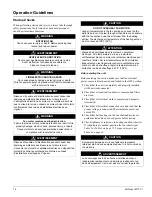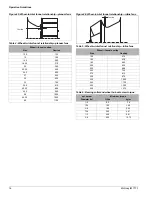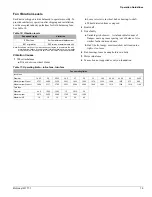
McQuay IM 777-1
7
Installation Guidelines
Dampers and Hoods
Side dampers may be provided in the mixing box and
economizer sections of units. When dampers are provided, a
removable panel is located above the weather hood to provide
access to the damper drive shaft. Other access may be available
depending on the specific construction of the unit. See Figure 14.
Figure 14: Filler panel over the weather hood
When units are ordered with exhaust hoods and intake hoods
adjacent to each other, install a field-supplied barrier to
prevent recirculation of exhaust air into the intake openings.
See Figure 15.
Figure 15: Field-installed barrier between hoods
Mounting Actuators
The installing contractor is responsible for the mounting of all
field-installed actuators. No provisions are made for the
location of these actuators due to the number of options and
arrangements available and the variety of specific applications.
Typically, actuators are mounted inside the cabinet. Provide
proper support for the actuator to avoid excessive stress in the
cabinet, linkage, or damper shafts.
Note –
Damper blades are at full flow when open to 70 degrees.
Do not open blades further than 70 degrees.
Fresh air and return air dampers can be linked together and
driven from the same actuator if the dampers are the same size.
If the dampers are different sizes, they must be driven by
separate actuators and controlled appropriately. Exhaust
dampers are always driven by a separate actuator.
A typical rotary electric actuator can handle up to 40 sq. ft. of
damper. For pneumatic actuators, allow 5 in-lb per square foot
of damper area.
Face and Bypass Section Mounting
Internal and external face and bypass sections are mounted
together using the instructions for horizontal components and
do not require additional instruction. Skyline air handlers are
provided with a bypass duct that is integral to the unit
construction and requires no field assembly.
Face and bypass dampers may or may not be linked together.
When dampers are placed before a single bank of coils, they
always are linked together and require a single actuator. When
dampers bypass a stacked or staggered coil, the dampers are
not linked and require multiple actuators.
Face and bypass dampers have a torque requirement of
10 in-lbs per square foot of damper face area.
Remove screws
and panel to access
damper control shaft.
Hood
E x h a u s t
I n t a k e
B a r r i e r
CAUTION
Maximum damper rotation is 70°.
Maximum shaft torque is 205 inches/pound.
Greater rotation or torque can cause equipment damage.
ATTENTION
La rotation maximale des colets est de 70°.
Le couple (torque) maximum de l’arbre est de 205po/lb.
Une plus grande rotation (ou torque) peut endommager
l’équipement.
Содержание Skyline IM 777-1
Страница 32: ...30 McQuay IM 777 1...
Страница 33: ...McQuay IM 777 1 31...
Страница 34: ...32 McQuay IM 777 1...
Страница 35: ......



































